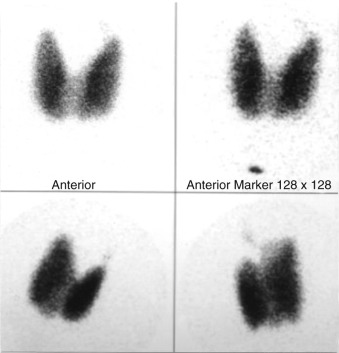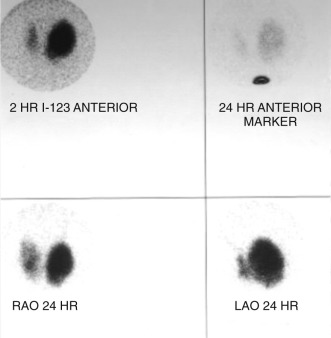Physical Address
304 North Cardinal St.
Dorchester Center, MA 02124
Patients should fast after midnight or, at a minimum, for 4 hours before receiving the radioactive iodine-123 ( 123 I) pill to maximize absorption through the gut. Patients should also avoid ingesting foods containing high amounts of iodine because they would saturate the iodine stores in the body and thyroid gland and diminish the uptake of the radioactive iodine. Foods such as shellfish and seaweed and supplements containing large amounts of iodine should be avoided. Patients should also discontinue taking any medication that would affect thyroid function, particularly thyroid replacement medication (for at least 2 weeks); thyroid blocking medication (propylthiouracil or methimazole for at least 5 days); and other medications, such as amiodarone, that contain substantial amounts of iodine. Finally, patients should not undergo scanning if they have received iodinated contrast agents as recently as 1 month before the scan (although sometimes the effects of such contrast agents on the thyroid can be seen up to 3 months later).
The most common radiotracers used in thyroid scintigraphy are the various isotopes of iodine. 123 I is the most commonly used isotope because of its excellent image quality and relatively low radiation exposure. Isotopes 125 I and 127 I are not typically used because of their high radiation exposure and worse image quality. 131 I is still used for thyroid imaging in some patients with thyroid cancer. Its higher photon energy theoretically makes it easier to detect cancer foci in the deep soft tissues in the body. However, 131 I is associated with a higher radiation exposure to patients, and the image quality is not typically as good as with 123 I. 124 I is a positron-producing isotope that can be imaged by positron emission tomography (PET) and has been shown to be valuable in the detection of residual thyroid tissue in patients with thyroid cancer. All of the iodine radiotracers are trapped by the thyroid gland and undergo organification into the thyroid hormones. The other primary radiotracer utilized for thyroid scintigraphy is technetium-99m ( 99m Tc) pertechnetate. This radiotracer is trapped (not organified) by the thyroid gland and can provide high-quality images. The amount of uptake of this radiotracer cannot be used to plan 131 I therapy, in contradistinction to that with the iodine radiotracers.
Thyroid images are obtained 24 hours after the administration of 123 I or approximately 30 minutes after 99m Tc pertechnetate. The gland should appear uniform throughout with smooth contours ( Figure 80-1 ). The isthmus and pyramidal lobes can be observed, although they are more commonly seen in patients with Graves' disease. Iodine uptake values are usually obtained at 2 and 24 hours after administration of the 123 I pill. The 2-hour uptake typically should be 2% to 10%, and the 24-hour uptake is usually 10% to 30%. These values may differ slightly, depending on the radiotracer that is used, so it is always important to know what a particular institution considers as the normal range of uptake.

The iodine uptake refers to the activity of the gland and not to whether the patient is hyperthyroid. Although a patient may have normal scan results and uptake values, if the thyroid function tests indicate that the patient is hyperthyroid, then a normal iodine uptake is still too high. A hyperthyroid patient should have a gland that is almost completely shut down. An uptake of 20% to 30% is too high if a patient is hyperthyroid with an undetectable thyroid-stimulating hormone (TSH) level. In such a setting, a patient with normal scan results can still have Graves' disease.
There are three possible outcomes:
A patient may be hypothyroid if the dose is sufficient to destroy most of the thyroid tissue and function.
A patient may be euthyroid if the dose diminishes the function of the thyroid gland, but there is sufficient activity to maintain normal circulating levels of thyroid hormone.
A patient may be remain hyperthyroid if undertreated, with the thyroid gland continuing to produce high levels of thyroid hormone.
In the hypothyroid case, patients typically begin undergoing thyroid replacement therapy. In the hyperthyroid case, patients usually require retreatment with a higher dose of 131 I. The likelihood of each outcome depends on the range of doses given. Lower doses result in fewer hypothyroid patients, with more patients requiring retreatment for persistent hyperthyroidism. Higher doses result in more patients being hypothyroid and fewer needing to be retreated.
Hot nodules (i.e., thyroid nodules with avid radiotracer uptake) are typically due to autonomously functioning thyroid adenomas. Hot nodules are typically treated with 131 I therapy but are often more resistant. It is usually recommended that the dose be higher than that used for treating a patient with Graves' disease. The overall approach to therapy is similar, however, including the patient preparation and radiation precautions that are followed after the dose is given.

Patients with hot nodules have a higher likelihood of ending up euthyroid because the hot nodule typically causes suppression of the remainder of the thyroid gland. This suppression protects the gland from 131 I therapy. When the nodule is eliminated by 131 I, the patient's thyroid function decreases, and eventually the TSH level begins to increase. This increased TSH stimulates the remaining thyroid tissue to begin producing thyroid hormone again. Because most of the suppressed tissue was protected, the patient may be able to make normal amounts of thyroid hormone.
Become a Clinical Tree membership for Full access and enjoy Unlimited articles
If you are a member. Log in here